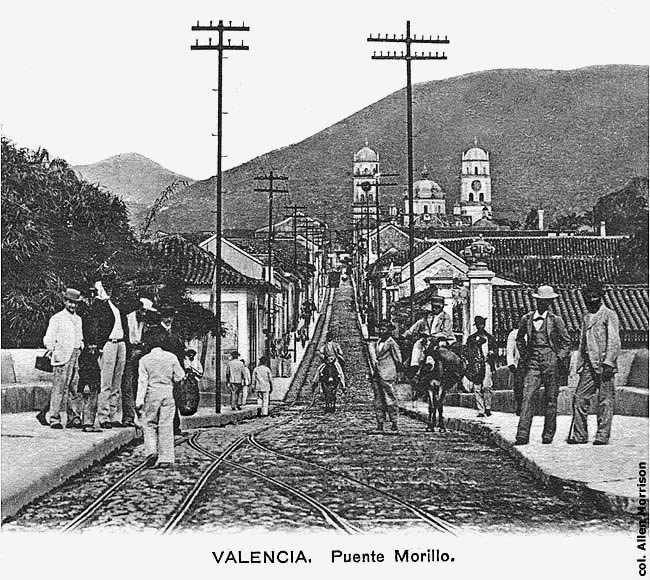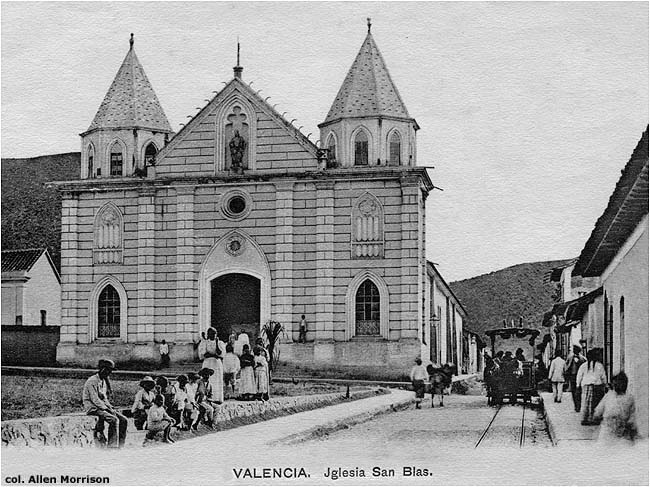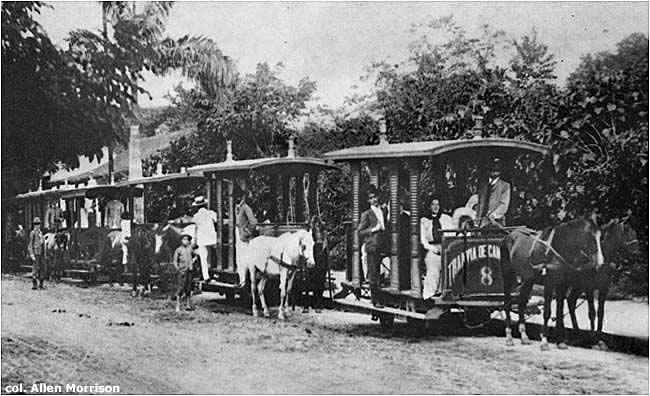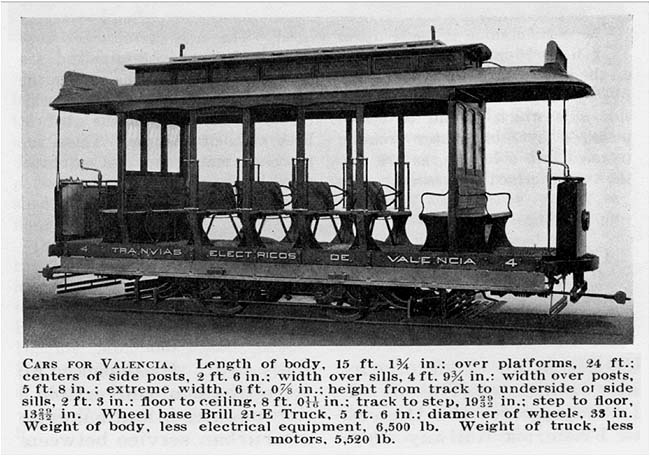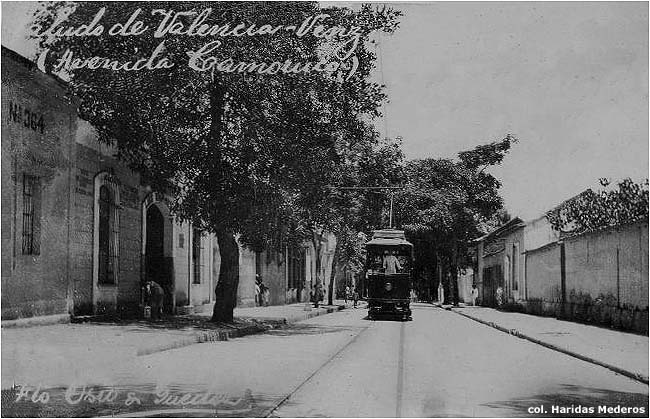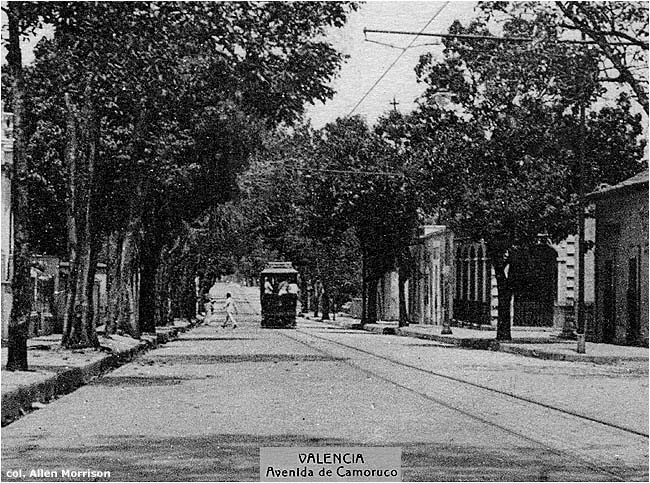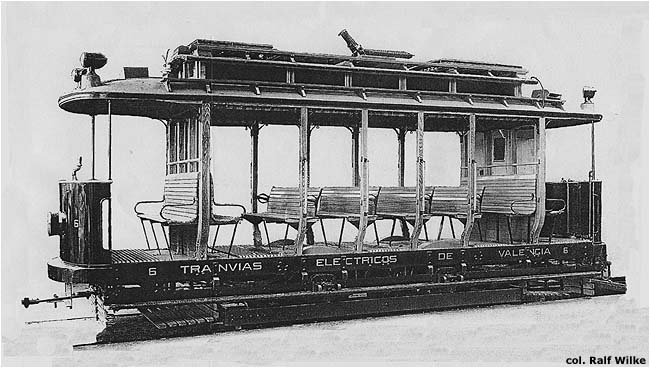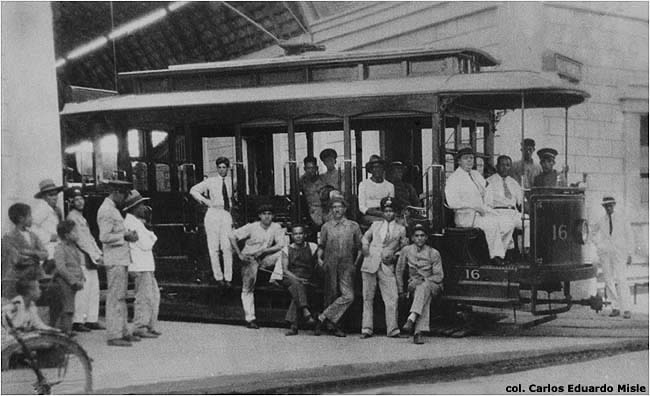The Tramways of VALENCIA Venezuela BY Allen Morrison
Valencia is the capital of Carabobo state and, with 1.5 million inhabitants, is the third-largest city in Venezuela (after Caracas and Maracaibo). Like Caracas, 150 km to the east, Valencia sprawls atop a mountain range, in this case at about 500 m (1,640 ft). It is 50 km from Puerto Cabello on the Caribbean. The Ferrocarril de Puerto Cabello a Valencia, which included a 4-km rack section, reached Valencia's Camoruco station in 1888 [see map]. The Gran Ferrocarril de Venezuela, the line from Caracas, arrived at San Blas station in 1894. Both steam railroads used the same 1067 mm (42 in) gauge and a track connection was eventually built across town between them. In anticipation of the arrival of the railroad from Puerto Cabello, and because Camoruco station is 3 km from the city center, plans for a tramway connection to Plaza Bolívar began in 1884 [see map]. The first franchise was awarded that year to Onofre B. Basalo. Rafael Romero Gonzalo signed another contract in 1886, ordered tramcars from John Stephenson Co. in New York, and inaugurated Valencia's first rail transport on 13 June 1887. Tracks were soon extended south along Av. Constitución to Palotal and east on Calle Colombia. The Stephenson Collection at the Museum of The City of New York has an undated photograph of a horsecar lettered "TRANVIAS DE VALENCIA - PLAZA BOLIVAR - PALOTAL". The postcard below, from about 1900, shows a scene on Calle Colombia on the east side of town. The photographer is facing west toward Plaza Bolívar, which is hidden by the cathedral [see map]. Morillo bridge in the foreground crosses Río Cabriales. The tram rails turning north go to the San Blas railroad station [col. AM]:
The image reproduced on the second postcard was also captured on Calle Colombia, in approximately the same place as the first, but in this case the photographer was facing the other way – toward the end of the tramway line. The tram is headed west, toward Plaza Bolívar [see map] [col. AM]:
At some point the name of the tramway company was changed to Tranvía de Camoruco, as inscribed on car 8 in this picture. These cars are similar to the Belgian model that was operated by Tranvía Bolívar in Caracas. Since Belgian records do not show any tram orders for Valencia, it is possible that the vehicles were purchased from Caracas after it electrified its tram lines in 1907 [col. Carlos Eduardo Misle]:
The early development of Compañía Anónima Tranvías Eléctricos de Valencia is unclear. The 1916 Memoria of the Ministerio de Obras Públicas [see BIBLIOGRAPHY] states that the company was organized by Ernesto Branger, a well-known local industrialist. R. S. Guerra wrote in 1960 that the company was founded by Juan Schwark. José Murguey Gutiérrez stated in a 1997 study that its founder was Carlos Stelling. In any case, TEV ordered four 8-bench electric trams from J. G. Brill Co. in Philadelphia on 25 February 1915. The photograph below was taken at the factory a few months later [Brill Magazine]:
The city's first electric tram service, between Camoruco station and Plaza Bolívar [see map], was inaugurated in December 1915. Track gauge was 1067 mm (42 in), the same used by electric tramways in Caracas and Carúpano and by the steam railroads that connected Valencia with Puerto Cabello and Caracas. As noted in the description, Valencia trams, like most trams in Venezuela, were only about 5 ft – 1.5 m – wide. The postcard view below shows one of them on the northern part of Av. Bolívar, which was called Av. Camoruco at that time [col. Haridas Mederos]:
In 1918 TEV ordered another 8-bench tram from Brill, which it numbered 5, but then made no further purchases from Brill for six years. There was still only one tram line in operation, between Camoruco railroad station on the north and San Blas railroad station on the east [see map]. The tram depot was located on Av. Bolívar at Calle Arismendi, near the Cedeño terminus of today's metro. The postcard view below shows Av. Bolívar again, on the north side of the city [col. AM]:
A tramway historian in Germany found the photograph below, which shows a tram built for Valencia in 1923 by Waggonfabrik A.G. vorm. Busch in Bautzen, a small industrial city near Dresden. Except for the flimsy seats, the car is similar in design and size to the Brill model shown above [col. Ralf Wilke]:
It is not known why TEV ordered a vehicle from that distant place: shipment through Germany, then across the North Sea and Atlantic Ocean would have been costly. But it is not certain that car 6 went to Venezuela. TEV ordered four more 8-bench trams from Brill in the period 1924-1927, which were numbered 7-10, and in 1930 purchased electric motors from English Electric in Preston, England, and built six trams in its workshops, which it numbered 11-16. New electric tram lines opened west on Calles 100 Colombia and 94 Cantaura and south on Av. 100 Bolívar Sur [see map]. This photograph of tram 16 was taken in Valencia in the 1930s [col. Carlos Eduardo Misle]:
The undated postcard
reproduced below – probably from about 1940 – shows a car on Plaza
Bolívar signed "La Pastora", which is a church on Av. 104 on the
Seminario line [see map]. The church in the background is the city's cathedral [col. AM]: 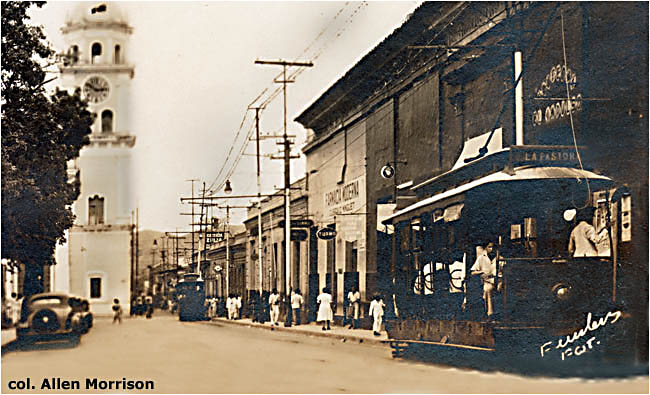 In 1940 Tranvías Eléctricos de Valencia built a 5 km trolleybus line along Av. 100, between the mercado (market) at Calle 98 Comercio and Calle 155 [see map]. A depot for the vehicles was established at Calle 123 and at Calle 130, just beyond Camoruco station, the trolleybus line crossed the tracks of the Ferrocarril de Puerto Cabello a Valencia. The Valencia trolleybus project imitated the system that had been operating since 1937 in Caracas and, like Caracas, Valencia built its own trolleybuses out of General Motors bus chasses [see Trolleybus Pioneers]. Valencia's trolleybus line is believed to have operated between 1941 and at least 1947, yet is unrecorded (until now) in world trolleybus literature and is ignored in Valencia city histories. No illustrations of the vehicles were found. Transport historian Luis Cordero Velásquez [see BIBLIOGRAPHY] claims that the Valencia tramway closed on 31 March 1947 (five months before the system in Caracas). He does not mention trolleybuses. The steam railroad to Puerto Cabello closed in 1957, the railroad to Caracas in 1966. The inauguration of the metro in Caracas in 1983 inspired plans for rapid transit in Valencia as well. C.A. Metro de Valencia was founded in 1991, construction began in 1997 and 12 articulated trains, assembled at the Siemens plant in Sacramento, California, USA, arrived at Puerto Cabello in 2000. President Hugo Chávez conducted a symbolic inauguration of the new metro in 2006 and full commercial service along the 6.2 km line, all underground, began on 18 November 2007. After an absence of 60 years, rails had returned to Valencia's main street [see map]. ------------------ Photographs and information about the tramways and trolleybuses of Valencia are obscure. This is one of the most elusive and frustrating places to research in South America. City histories, all of them, ignore urban transportation – and the fact that modern Valencia would not exist without it. Had it not been for news items published in English transport journals in 1940 and 1941 [see BIBLIOGRAPHY], the author would never have suspected that Valencia had a trolleybus system. (Since the vehicles were home made, there are no clues in the records of trolleybus manufacturers.) However, no further information or confirmation of the service could be found. The author mentioned this mystery in the first version of this webpage and received an email from Sr. Hans Klein in Caracas, who had ridden trolleybuses to school when he lived in Valencia as a boy. With his extraordinary memory and special interest in electric technology, Sr. Klein recalled every detail of the operation – the route, the vehicles, the location of the depot, even the fares that were charged! The author wishes to express his sincere gratitude to Sr. Hans Klein of Caracas for the information that he so kindly provided about the trolleybuses that ran in Valencia, Venezuela, 60 years ago.
BIBLIOGRAPHY "Open Cars for Valencia, Venezuela" in Brill Magazine (Philadelphia), August 1915, pp. 249-250. Description of the electric trams built for Valencia. Article includes the photograph of car 4 that is reproduced above. Venezuela. Ministerio de Obras Públicas. Memoria of 1916, vol. 1, pp. 121-122; and vol. 2, p. 200. Chapters entitled "Tranvías de Valencia" describe early horsecar development and the formation of the electric tramway company. "Eight-bench Open Cars for Venezuela" in Brill Magazine (Philadelphia), August 1925, p. 313. Short article about the model built for Caracas and Valencia. Picture of car 56 sent to Caracas. U.S. Dept. of Commerce. Bureau of Foreign & Domestic Commerce. World Survey of Foreign Railways. Washington, 1933 and 1936. Both editions of the survey briefly describe the Valencia tramway system. "Replacement of Caracas Tramways" in Modern Transport (London), 22 June 1940, p. 11. Article about the reconstruction of gas buses as trolleybuses mentions eight vehicles planned for another city (which must be Valencia). Passenger Transport Journal Directory & Year Book. London. Paragraphs about Valencia on p. 31 of the 1940 edition and p. xxxiii of the 1941 edition mention "5 km of trolleybus route under construction". [No author or publisher indicated] "Plano de la Ciudad de Valencia, Capital Del Estado Carabobo", scale 1:4,000. Valencia, [1942]. Large street map shows the track layout of the tramway system and marks the location of the "T. E. de V." depot. Venezuela. Ministerio de Obras Públicas. Cartografía Nacional. "Valencia" street map, scale 1:10,000. Caracas, 1948. Railroad detail. R. S. [Rafael Saturno] Guerra. Recado Histórico sobre Valencia. Valencia, 1960. Several untitled paragraphs on pp. 152-153 sketch tramway development and name the electric tram routes. Luis Cordero Velásquez. La Venezuela del Viejo Ferrocarril. Caracas, 1990. Chapter XXXIV entitled "Los Tranvías de la Urbe del Cabriales", pp. 257-258, states that Valencia's last tram ran on 31 March 1947. José Murguey Gutiérrez. Construcción, Ocaso y Desaparición de los Ferrocarriles en Venezuela. Mérida, 1997. Chapter 9 on pp. 287-295 is entitled "Los Tranvías en Venezuela" but is concerned principally with corporate history of the lines in Caracas. Footnote 340 on p. 295 says that Valencia's electric tramway company was founded by Carlos Stelling. Guillermo Mujica Sevilla. Desde el Solar Valenciano V. Valencia, 2000. The chapter entitled "Carbón y Ferrocarril" on pp. 17-19 describes the rack railway from Puerto Cabello and reproduces two small photographs from 1923 which show electric trams 4 and 5.
See The Tramways of Macuto, La Guaira & Maiquetía See The Trolleybuses of Mérida See my index of If you have comments, criticism or suggestions, This site was placed online on ALL RIGHTS RESERVED TODOS LOS DERECHOS RESERVADOS |
